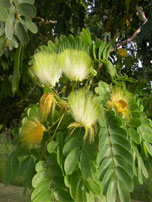SHAHEED KARTAR SINGH SARABHA AYURVEDIC MEDICAL COLLEGE & HOSPITAL
Affiliated to Guru Ravidas Ayurved University, Hoshiarpur Punjab
Affiliated to Guru Ravidas Ayurved University, Hoshiarpur Punjab

Botanical Name : Albizia lebbeck (Linn.)Benth.
Family : Mimosaceae
Introduction :
Vedic literature extensively quoted sirisa among the Sãnta Vrksas. In sustra stana describes it is one of the best plants for Danta Kãsthas (tooth brushes).
Scientific classification : The albizias are members of the subfamily Mimosoideae, family Fabaceae (formerly Leguminosae). The silk tree is classified as Albizia julibrissin, and the plume albizia is classified as Paraserianthes lophantha.
Names in different Indian languages :
English : Siris tree
Hindi : Siris
Kanada : Begemara
Sanskrit : SIRISA
Malayalam : Nenmenivaka, vaka
Tamil : Vakai, siridam
Telugu : Dirisana
Marathi : Siras
Punjabi : siri
Gujarathi : sarsado
Bengali : sirosh
Synonyms :
Kapitanch; Mridu pupa, Bhandi, Bhandirah, Sukataru, Suka priya,Suka pupa, Bhandila, Shitapushpa, Mridupushpa, Kapitana
Classification according to Charaka, Susrutha & Vagbhata :
Charaka
Visaghna, Vedanãsthapana, sirovirecana, Kasãya skañdha
Susrutha
Sãlasärãdi
Vagbhata
Asanãdi
Varieties & adulterants – (CV – controversy, AD – adulterants) :
1. Albizia amara (Roxb.) Boiv. – Krsa Sirisa
2. A. odoratissima Benth. – Krsa Sirisa
3. A. procera (Roxb.) – sveta sirisa
4. A.lucida Benth
5. Kantaki sirisa.
6. Albizzia julibrissin
Albizia julibrissin rosea
Morphology :
It is a deciduous, erect, spreading tree, growing to 18 -20 m. height. With umbrella shaped crown.
Bark- rough cracked, dark-brown to greenish-black with transverse and longitudinal striations inside.
Leaves- compound, bipinnate 2-4 pairs, with 8-18 leaflets , glands between the bases.
Flowers – Inflorescence- in globose heads of greenish-yellow flowers,
Fruits- pods, yellowish-brown, with 6-10 seeds.
Seeds- 4-12, pale brown, ellipsoid, oblong, compressed
(Flowers during rainy season and fruits during winter).
Distribution & Habitat :
All over India, from the plains up to 1800m. the Himalayas; also in the Andamans
Chemical constituents :
Triterpenoids , triterpenoid saponins; oleanolic acid, albigenic acid, albigenin, acacic acid.
Bark- condensed tannins viz., D-catechin, lebbecacidin, (-) melacacidin, friedelin, beta-sitosterol.
Heart wood- Lebbecacidin, leucopelargonidin, melacacidin, melanoxetin, okanin, (+) pinitol
Seeds- Proteins, amino acids
Flowers- benzyl alcohol, benzok acid, p-nitrobenzoate etc.
Leaves- caffeic acid, kaempferol, mynicitrin, reynoutnin etc.
Properties :
Rasa – Kasaya, Tikta, Madhura
Guna -Laghu, Ruksa, Tiksna
Vipãka-Katu
Virya- Usna (Anusna)
Karma : Tridosahara, Varnya, Visaghna, sotha hara,
Expectorant, anti – inflammatory, Antiseptic, antibacterial, antiallergic, antidermatosis, antidysenteric
Indications :
Visa roga, Kãsa, Vrana, Visarpa, Kustha, Krimi, pamara kushta,
asthma, leucoderma, erysipelas, sprains, ulcers, neuralgia, diarrhea, catarrh, seminal weakness,piles, bronchitis, tropical pulmonary eosinophilia, skin disease
Part Used :
Stem bark, seeds, flower, leaves
Dosage :
Powder 3-6 g; decoction 50-100 ml; fresh juice 10-15 ml.
External uses :
Anti-inflammatory, analgesic. antitoxic. beneficial to complexion, and beneficial to eyes. Seed paste is applied in kushtta – dermatoses and in wounds, bark paste is applied. In toothache and looseness of tooth – gargling with bark decoction is done. It is also applied externally in various types of poisoning & eyes diseases like night blindness.
Internal uses :
Digestive system : Astringent, but in high doses vomiting occurs. Bark powder gives strength to the gums.
Circulatory system : Purifies blood, anti-inflammatory, useful in blood diseases, herpes. inflammation, lymphadenopathy. In all these diseases, bark decoction or seed powder is given.
Respiratory system: Shirovirechan (nasya) and kaphaghna. Therefore used in cough etc. In chronic kaphaja jwar seed powder is used for pradhama nasya (nasal administration). In asthma. flowers reduces the headache in migraine.
Reproductive system : In poor semen quality, seed powder with milk is given for vitalization. Powers are used in delayed menstruation or delaying ejaculation.
Skin : In dermatitis seed powder is used.
Satmikaran Antitoxic : In organic and inorganic poisoning, bark decoction or seed powder
Important Yogas or Formulations :
sirisãrista, Panca sirisa ghrta, Pañcasirisagadah; Mahashireesh Agad, Shireesharishla.
Therapeutic Uses :
(1) Sarpavisa– sveta Marica soaked in sirisa flower juice for 7 days is used for Nasya, Pänna and Anjana (C.S.Ci.33 & Vr.Mã.).
(2) Suryavarta & Ardhãvabhedaka- Nasya of the seeds of sirisa & Mulaka may be useful (S.S.Ut.26 & V.M.)
(3) Kustha- Paste of the bark of sirisa is useful (C.S.Ci.7 & A.H.Ci.19).
